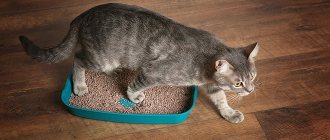When purchasing a pet, be prepared for the cat to sharpen its claws on wallpaper and upholstered furniture. To get rid of problems with an adult, it is recommended to accustom the kitten to a scratching post at the age of 1-2 months. I use modern tricks and traditional methods, this process will go quickly, sometimes you can train a pet in 1 day.
Americans take a radical approach to solving the problem: they take the pet for an onychectomy (a surgical operation to remove claws, mainly from the front legs). It is better to abandon unnecessary injury (according to the British Royal College of Veterinary Surgeons) and teach the cat to use a scratching post in the apartment.
Why does a cat tear up furniture?
Cats are used to sharpening their claws. They have no intention of ruining things. The cat sharpens its claws to remove dead particles, smooth the surface and sharpen the tips. This is a kind of exercise for the paw muscles. Surely the owners have noticed how the pet stretches sweetly after waking up and extends its claws to cling to something nearby.
Cats mark their territory this way. The glands located on the paw pads exude a characteristic secretion, the aroma is felt only by animals. Performing a daily “ritual,” cats strive to reach the top mark with their paws in order to create the appearance of a large and scary predator that left this mark.
A scratching post is a useful accessory that can protect furniture and wallpaper from cat attacks. However, in practice, teaching a pet to stand is much more difficult than, for example, teaching a pet to relieve itself in a litter tray. After all, this process involves confrontation with nature itself and is equivalent to training a cat.
What should you pay attention to when choosing a scratching post?
When choosing a scratching post, you need to consider several factors. Firstly, it must be durable. If the product is vertical, it should be tall. The cat will ignore the short sharpener.
Secondly, the sharpener should not swing or move. The stability of the product is ensured by a wide, heavy base. If the scratching post moves, the cat may get scared. In addition, such a sharpener may fall on the cat and he will no longer dare to approach it.
Your cat should like the texture of the sharpener. You should not buy an item with plastic elements or artificial winding. These materials are static and can shock your pet.
Each tailed animal should have its own sharpener. If there is only one, pets may mark it over and over again to remove the foreign scent. Because of this, it will spoil in a few weeks.
Every furry friend should have their own favorite scratching post.
What measures should not be used when training a cat?
You cannot hit or scream at your cat if it has once again tested the strength of the sofa. The pet will be scared, but it is unlikely to understand why they are angry with him. It’s better to say sternly: “You can’t,” and hit the floor with a slipper or clap your hands. The animal will be wary and understand that this is not worth doing.
Attention! Cats are vindictive by nature. For any aggression in their direction, they are ready to commit meanness. If you yell at her or hit her, for example, she may relieve herself on the bed.
You should not spray your cat with water from a spray bottle when it begins to sharpen its claws. Of course, contact with water is unpleasant for a pet, which means contact with a carpet, sofa or something else into which its claws have previously dug will be associated with danger that should be avoided. However, this method can hardly be called humane.
Important! Sometimes cats sharpen their paws not because they feel the need. They strive to attract attention because they remember that after damage to furniture or a carpet, people start yelling at them.
Owner reviews
Many cats do not like small scratching posts - it should be 65 - 70 centimeters high - otherwise the cat will not be able to stand on its hind legs and stretch out. When caught in the act of a crime, you take him to the scratching post and scratch it with his paws. Treat the scratching post with catnip - and show it to the cat - many people react well to mint... Many people love corner scratching posts... When you leave, you can put a cover made of polyethylene film on the sofa... Or, leaving the cat alone, close the room - his bed is in the corridor, let him go to the kitchen to eat, to the toilet and that’s it...
OAya
https://www.u-mama.ru/forum/family/pets/714922/index.html#mid_23985664
To get started, buy either a special training spray or catnip. smear/spray the scratching post, the cat should be interested. Next, every time the cat sharpens its claws in the wrong place, you punish it (you can spray it with a spray bottle), and if it’s in the right place, then praise it very, very much, give it patience and time.
Nuiladna
https://www.e1.ru/talk/forum/read.php?f=74&i=413805&t=413805&
Try putting her “awake” on the scratching post, usually the kittens begin to stretch and sharpen their claws, I taught mine that way. And simply bringing it to the scratching post several times a day and putting its paws on it is usually understood. You can try to lure it with a teasing toy, move it up and down - the kitten starts jumping up on its own. Immediately stroke and praise the child... Mine, after a week, realized that the scratching post is nicer, and “mom” does not swear, but praises... Also, pay attention to where the scratching posts are and where the kitten likes to sharpen his claws - maybe move it to that place ?
Ksana
https://mauforum.ru/viewtopic.php?p=15273
Firstly, the scratching post really needs to be placed where your pet is used to sharpening its claws. They come already impregnated with a special composition that attracts cats. Even if the cat does not want to use the scratching post at first, over time it will begin to get used to it. There is also this trick: veterinary stores sell a special herb called catnip. Cats love her very much. It usually comes in dry form and is sold in a bag. You can hang this bag next to the scratching post, it will attract the cat with its aroma, or you can simply rub this mint on the scratching post itself. Try it, it gives results. In addition, scratching posts come in the form of a ball - a toy. A ball wrapped in these same ropes for sharpening claws. A very cool toy. The cat plays with him, jumps on him, grabs him with his paws and at the same time sharpens his claws. So there are many options for weaning your cat from sharpening its claws on furniture.
Valentina Bragarnik
https://forum.koschki.ru/index.php/topic/34-kak-priuchit-vzrosluiu-koshku-k-kogtetochke/
You can also try different options for the position of the scratching post (including different scratching posts - if you can’t try one) - vertical, inclined, horizontal. Cats have different preferences. My tail sharpens its claws exclusively on the vertical scratching post, and the horizontal one is lying around unattended.
Robust
https://forum.mau.ru/viewtopic.php?t=60099
And also, as it turned out, it is important not only what it is made of, but also WHERE it is located!!! According to my observations, cats prefer soft fabrics, cats prefer tougher ones, and the last Cat “clawed” an unpainted linden baseboard into two parts in 4 years - I’m honestly not kidding! Now Kosha and I have two scratching posts in the house: - a corner one, attached to the corner in the corridor, in the “slip point”... when Kosha has “Tygydym games”, running from the kitchen to the room, she no longer skids as before, but bounces off vertically attached corner scratching post... -and the second one lies on the floor in front of his favorite chair...so “on the way to the bedchamber” and barely waking up, Kosha stretches and claws this scratching post
OpaUps
https://forum.33cats.ru/index.php?topic=78
We bought a column of balloons for ours and sprayed “kotovik” on it. For 2 weeks she didn’t pay any attention to him, and then she was replaced. She loves this column, but... sometimes in moments of loneliness she kisses the sofa. Considering that we started training her when she was already 2 years old and she was tearing up not only the sofa but also the walls and door frames, then the post helped us a lot.
Box
https://forums.zooclub.ru/showthread.php?t=2977
How to accustom a kitten to a scratching post
The first steps in the process of accustoming a cat to a scratching post should be arranged in a certain order.
- Introducing the scratching post. You need to attract the kitten's attention to the scratching post in a playful way. You should stand near the accessory and tease your pet with a moving toy or any other object that can arouse the animal’s interest. The kitten will play around and wrap its paws around the scratching post.
- After waiting for this moment, the owner can quietly scratch the counter with his nails. The animal will hear the sound and may want to join in exploring the new thing.
- If, after the above-described manipulations, the kitten does not understand the purpose of the accessory, it is necessary to place the scratcher in a horizontal position and play with the animal around it. The cat will probe the surface with its paws when it accidentally jumps onto the scratching post while hunting for a toy. After a while, the pet will begin to use the nail clipper without the owner’s prompting or help.
- As soon as the animal develops the skill of sharpening its paws on a special stand, the scratching post can be returned to its original position, more convenient for the owner.
The best effective method of training a scratching post is to play with the kitten near the counter.
Like many other manipulations with animals, this habit is best developed at a tender age. Especially if the kitten tried to copy its mother and repeated the same actions after her. Therefore, it is good when the baby’s parents are already accustomed.
Features of training depending on the age of the kitten
1-1.5 months
At this age, patience and cat treats will be your helpers.
- Take the kitten's favorite treat and call him to the scratching post.
- Raise the treat over the kitten so that he reaches for it and puts his paws on the scratch pad.
- Praise him for this and give him a treat.
- Stroke and talk affectionately.
- Repeat these steps until the baby learns to sharpen his claws in the right place.
2-2.5 months
Grown-up kittens are trained in the form of a game. They attract attention with the help of toys and show how to sharpen their claws. The owner’s main goal is to show the pet that this new item can be fun to play with. Positive results are rewarded with praise and treats.
4-5 months
As kittens mature, they develop their own preferences and form habits. The main efforts of the owner of such a kitten should be aimed at combating scratching of furniture and carpets. Inappropriate places for scratching should be made unattractive and repulsive. And attract attention to the scratching post with sprays or other scents that cats like (catnip, valerian).
Video
Six effective tips
Below are some helpful tips that will help you succeed in training your kitten to use a scratching post:
- Encourage your petwhen he independently approaches the counter and begins to cling to it with his claws. You can praise, pet or give a treat.
- Do not grab your pet by the paws and force him to scratch the scratching post. Even if the owner does this carefully and gently, the kitten still will not understand what they want from him. He won't like it. The animal will try to escape from your hands, and the scratching post will already be associated with something unpleasant
- Try to attract your cat with mint. Do not use valerian (valerian), it, like a drug, distorts behavior and dulls the cat's instincts. Take a small amount of catnip and sprinkle (spray) the counter. This product attracts cats well, they begin to rub, purr and release their claws with pleasure.
- When playing near the counter, be attentive and consistent in your actions so that your pet clearly understands what they want from him.
- Do not play with the animal near curtains or furniture. By grabbing an object, the kitten will think that it can scratch other nearby things.
- Cover the corners of the sofa and other furniture with something rustling, such as bags or foil, while training you to use the scratching post. If a cat pulls up the carpet, it should be removed until a useful skill is finally established in the pet’s behavior.
For kittens, it is recommended to buy horizontal scratching posts in the form of boards trimmed with jute or sisal. Wooden ones are not the best option at a tender age, since the paw pads of small pets are too soft and susceptible to mechanical damage.
Aids
There are several additional techniques that will help stop your cat from tearing up pieces of furniture, carpets, wallpaper and other things:
- All places that the pet has chosen for its bad deed should be sprayed with a product (deodorant, air freshener, etc.) with a strong smell of citrus crops (lemon, grapefruit, orange, etc.), cheap perfume or cologne. You can hang small linen bags with dried zest or strong-smelling seasoning (coriander, pepper, etc.). Veterinary stores have special repellents: Api San, Bio Vax, etc.
- Cats do not like water and this fact is used to scare away the animal when trying to put its claws into a prohibited object. As soon as the cat is about to scratch the furniture, you should immediately spray the liquid directly into his face. It is extremely important to do this in a timely manner, that is, either before the attempt or no later than a few seconds after it. Otherwise, your pet will not have any connection between these events.
- An excellent way to train is to use harsh sounds. When the cat intends to do some mischief, you need to clap your hands or make noise with a rattle. Even a simple glass jar with a few coins placed inside is suitable for this. If you do this systematically and methodically, then sooner or later the pet will learn the owner’s rules.
- Voice commands that are given loudly and loudly are also effective. This should be repeated until the pet stops trying.
- Sometimes it is recommended to use inflated balloons, which are placed near your pet’s favorite places. They are burst at the moment when the cat encroaches on the sofa or wallpaper. A loud bang will scare her, and another time she will be afraid.
- Double-sided tape is very helpful in stopping cats from mischief. They are used to cover surfaces that are subject to scratching.
When trying to tear up a sofa, you need to spray water on the cat's face
From personal experience. Cheap men's cologne, which had been in the closet for many years, helped stop the cat from scratching the sofa. They sprayed all the furniture with it. The smell was not particularly pleasant, but I had to endure it.
On sale you can find special devices equipped with motion sensors. They spray a repellent odorous liquid when an animal approaches.
What not to do
When weaning your pet from bad habits, you should remember a few simple rules:
- In no case should you use physical punishment or beat the cat, it may become embittered and begin to take revenge;
- Don’t shout too loudly at your pet, it’s better to use a characteristic intonation (cats pick it up well);
- You shouldn’t throw away an old scratching post if it has become unusable (it’s better to restore it rather than buy a new one, so the familiar smell will remain on it);
- shaming a cat some time after committing a crime makes no sense; it will not understand why it is being scolded.
Under no circumstances should you hit a cat
Simple prohibitions and threats do not apply to cats. You need to act with cunning and affection, and also reward your pet with treats in a timely manner.
If the cat did everything correctly, then he needs to be petted and praised
How to train an adult cat
Adults are smart, just like kittens, so the process of accustoming to a scratching post will not take longer. You need to act as in the case of a kitten:
- Bring your pet to the counter; in this case, you can move its paws along the upholstery of the scratching post.
- If necessary, use additional motivation - play a toy with her, moving the mouse or feather along the surface.
- You can, as in the case of a kitten, rub the upholstery with catnip leaves, the main thing is not to overdo it, cats have a keen sense of smell and a pungent smell can scare off the pet.
Important! If the previous tips turned out to be ineffective, you can rub the surface of the counter with a rag that you previously stroked a strange cat. The animal, sensing someone else's scent, will begin to mark the territory using its claws. However, it should be remembered that cats can mark in a slightly different way. If urine gets on the scratching post, a clean cat will most likely refuse to sharpen its claws on it in the future.
Tricks that will help train a cat to sharpen its claws on a scratching post in 1 day
Experienced breeders and veterinarians advise resorting to a number of tricks to quickly accustom a cat to a scratching post. By influencing the natural instincts of an animal, you can achieve impressive results. The training will take from 1 day to a week.
- To accustom a cat to a scratching post, it is worth treating the surface with a spray that contains catnip extract. Can be sprayed with decoction: 1 tbsp. spoon in a glass of boiling water, infuse for 20 minutes.
- If you make your own nail clipper, three or four leaves of dried grass are placed between the base and the ribbed surface to attract the cat's attention.
- If the kitten is small, you can apply the mother's scent to the scratching post: wipe with a cloth that was previously used on the cat.
- To accustom an adult cat to a scratching post, the smell of an enemy adult animal is applied to the surface as an irritant.
- Simultaneously with taming the scratching post, other areas are treated with an “Anti-claw” type spray, water to which citrus essential oil has been added, or the areas are rubbed with fresh orange peels (carefully, this can damage the furniture).
Caution: Valerian is a strong irritant for cats. If you decide to use pharmaceutical drops, dilute no more than 2 drops in a glass of warm water, and then spray the claw cleaner with a spray bottle.
What will help attract a cat to the scratching post?
To attract your pet to the scratching post, you first need to wean it from sharpening its claws in the usual way, that is, on furniture, wallpaper, etc.
- Will help scare your pet away from the sofa or carpet sharp citrus smell. Treat your favorite nail sharpening areas with lemon juice. This will keep the animal away from them for a long time.
- Cats do not accept polyethylene , because its surface does not leave the slightest chance for claws to catch on. And the bubble wrap actually creates fear in the cat. Cellophane should be used to cover furniture and places (wallpaper and doors) that the pet has chosen. For these purposes double-sided tape sold in pet stores will do. When a pet wants to sharpen its paws, it will begin to stick to the surface, and cats don’t like that.
- As mentioned earlier, the smell of catnip, toys attached to a scratching post, and rewarding with treats when the cat behaves correctly will help attract a cat.
All protected areas need to find a replacement - a scratching post. You can buy it in a specialized store or make it yourself. It’s better to take or make several and place them in your favorite places, and then begin the training process according to the recommendations described above.
If you can’t train your pet to use a scratching post, you can try the following:
- change the location of the stand, moving it to the corner where the cat is used to getting a “manicure”;
- hang your pet’s favorite toy on the stand (or better yet, a bell or rattle, such things can arouse greater interest in the cat);
- treat the upholstery with catnip powder or solution;
- observe the animal and determine which surfaces it scratches most often: vertical or horizontal and which material is of greater interest. This will help when choosing a scratching post.
Types of scratching posts
The choice of scratching post should be approached carefully, first of all, based on the character, temperament and habits of the animal.
There are 4 types of scratching posts that your pet may like:
- Column. Suitable for active animals who like to jump and climb. Positively affects the skeleton and muscle development.
- Little house. Purchased for cats that like to hide.
- Playground. For restless pets who constantly climb cabinets and curtains. Various labyrinths and stairs will release excess energy and help you cope with the main task - the claw point.
- Mounted. Use by nailing it to the wall or leaving it on the floor. The cat will be able to stretch out comfortably, scratching it with his claws.
Scratching posts are also classified according to the type of material used:
- Cardboard.
- Jgutovaya.
- Sisal.
- Wooden.
In pet stores you can find horizontal, vertical and corner products.
Choice
You should choose them based on your pet’s preferences; to do this, you should watch him and determine how he likes to sharpen his claws.
For example, if a pet does this on the floor on a carpet, then a horizontal one will suit him. In case of damage to the wallpaper - vertical, and if he prefers a new sofa - corner. It should be installed in your favorite places.
If there is a kitten in the house, then you should choose a scratching post with attachments for toys. This way the baby will approach her more often, and it will be easier to interest him in her.
1111
Useful video
Video instructions on how to accustom a kitten and an adult cat to a scratching post:
Patience, persistence and regular repetition will help train even the most stubborn pets. There is such a procedure in the world as removal of nail phalanges. However, in many countries it is equated with mutilation and is opposed to these actions, and we are of the same opinion.
If you can’t get your cat accustomed to a scratching post, then you can think about using silicone anti-scratch pads or trim your pet’s claws more often, and our article on proper claw trimming will help you with this.
Everyone is responsible for those they have tamed, therefore, when taking a new animal into your home, it is important to understand all the responsibility and natural needs of pets. Accustoming to a scratching post is a complex process that requires a lot of time, but this is the only option when, as they say, both the wolves are fed and the sheep are safe. Leave comments on the article about what methods you know of training a cat to use a scratching post.
Why do cats sharpen their claws?
Claw pointing is a natural process that occurs in every cat. Many owners believe that this action is nothing more than cat pampering or an attempt to harm. This opinion is fundamentally wrong. The habit of sharpening claws is equivalent to pulling up and playing with a ball. That is, it is necessary to maintain health and normal physical shape.
In addition, with the help of the point, the cat is freed from too long and exfoliated claws. If you do not allow the animal to carry out this action, then it will try to chew them off, which will lead to their fragility and delamination. This can cause inflammation of the nail bed.
Getting rid of bad and long claws and physical activity are not the only reasons. If we talk about the innate instincts that are inherent in every four-legged animal, then this process is needed to mark the territory. It is known that a special liquid is secreted through the pads on the paws - a secret that is felt only by animals. This action should demonstrate to everyone who is boss and show that the territory is already occupied.
While sharpening their claws, cats often damage furniture.
In addition, after waking up from sleep, cats need to warm up their muscles. To do this, they stretch out and cling tightly to the carpet or sofa with their claws.
Many veterinarians believe that this procedure is a great way for cats to relieve stress, expel all their anger and release excess energy.
Important! It is best to start learning in childhood. Kittens are very inquisitive and absorb new information like a sponge. It is much more difficult to train adult cats, who have long tested the strength of carpets and furniture upholstery.
Give your cat a manicure
A radical, but not mocking, way out of any of the listed situations is trimming the tips of the claws or special overlays for the claws. The first method is described in detail in our other article, “Cutting cats’ claws,” and about claw covers, let’s say that these are special cases in which a claw is placed, as a result of which your pet will not damage anything in the house. However, we consider this option to be the least desirable, because The pads need to be glued, and the cat is uncomfortable in them.
Rate and share!
How to choose the right one
To make the right choice, you should be guided by the following criteria:
- Breed. If the breed is characterized by large sizes, then it is worth choosing a drape of appropriate dimensions. When the animal outgrows the purchased device, you will have to buy a new one.
- Type of drapery. Determine what the cat scratches most often: the door, sofa, carpet or wallpaper. Based on this, a choice is made in favor of a vertical or horizontal device. Its location directly depends on the type chosen.
- Material. It all depends on the budget. If funds allow, it is better to take wooden products or sisal-coated alternatives.
- When choosing a scratching post, you need to pay attention to its stability. Horizontal devices are safer because they lie on the floor. Problems may arise with vertical posts.
- If the cat falls along with the drape during the point, the animal may become frightened and no longer approach the danger zone.
- If space allows, you can purchase several types of products and place them in different places.









